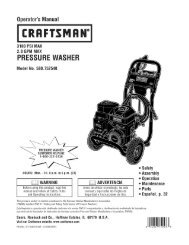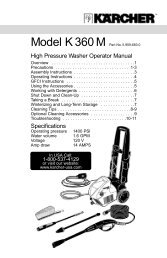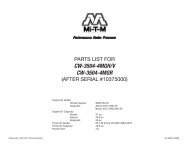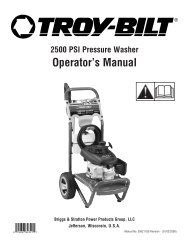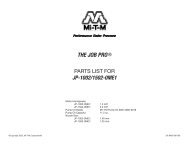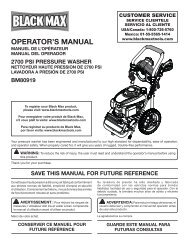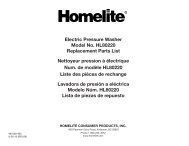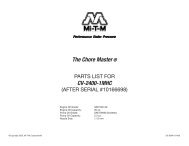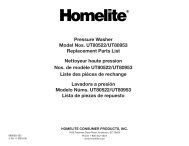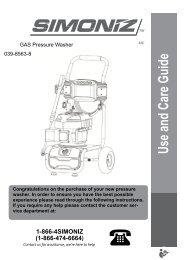OPERATOR'S MANUAL - Ppe-pressure-washer-parts.com
OPERATOR'S MANUAL - Ppe-pressure-washer-parts.com
OPERATOR'S MANUAL - Ppe-pressure-washer-parts.com
You also want an ePaper? Increase the reach of your titles
YUMPU automatically turns print PDFs into web optimized ePapers that Google loves.
OPERATION<br />
n Release the trigger to stop the flow of water through the<br />
nozzle.<br />
To engage the lock out:<br />
n Push up on the lock out until it clicks into the slot.<br />
To disengage the lock out:<br />
n Push the lock out down and into its original position.<br />
For the most effective cleaning, the spray nozzle should be<br />
between 8 in. and 24 in. from the surface to be cleaned. If<br />
the spray is too close it can damage the cleaning surface.<br />
SELECTing the RIGHT QUICK-CONNECT<br />
NOZZLE FOR THE JOB<br />
See Figure 21.<br />
Before starting any cleaning job, determine the best nozzle<br />
for the job. Each of the nozzles has a different spray<br />
pattern. The nozzle patterns are: 25° (for general purpose<br />
or large surfaces), 15° (for tough jobs), 0° (for spot cleaning<br />
or hard-to-reach areas), and the Soap Blaster nozzle (for<br />
long and short range detergent application).<br />
WARNING:<br />
NEVER change nozzles without locking the lock out on<br />
the trigger handle and never point the wand at your<br />
face or at others. The quick-connect feature contains<br />
small springs that could eject the nozzle with some force.<br />
Failure to heed this may cause personal injury.<br />
Using the quick-connect collar, changing nozzles is easy.<br />
n Turn off the <strong>pressure</strong> <strong>washer</strong> and shut off the water<br />
supply. Pull trigger to release water <strong>pressure</strong>.<br />
To connect a nozzle to the trigger handle:<br />
n Engage the lock out on the trigger handle by pushing up<br />
on the lock out until it clicks into the slot.<br />
n Push the nozzle into the quick-connect collar until it clicks<br />
in place and is secured properly.<br />
To disconnect a nozzle from the trigger handle once the<br />
cleaning job is <strong>com</strong>plete:<br />
n Turn off the <strong>pressure</strong> <strong>washer</strong> and shut off the water<br />
supply. Point nozzle in a safe direction and pull trigger to<br />
release water <strong>pressure</strong>.<br />
n Engage the lock out on the trigger handle by pushing up<br />
on the lock out until it clicks into the slot.<br />
n Remove the nozzle by placing hand over nozzle then<br />
pulling back the quick-connect collar. Place nozzle in the<br />
nozzle holder for storage.<br />
washing with detergent<br />
See Figures 22 - 23.<br />
NOTE: When using detergent, the coiled high <strong>pressure</strong><br />
hose can be relocated to the hook-and-loop strap located<br />
behind the handle bar instead of the strap located on the<br />
carrying handle.<br />
Use only detergents designed for <strong>pressure</strong> <strong>washer</strong>s; household<br />
detergents, acids, alkalines, bleaches, solvents, flammable<br />
material, or industrial grade solutions can damage<br />
the pump. Many detergents may require mixing prior to use.<br />
10 — English<br />
Prepare cleaning solution as instructed on the solution bottle.<br />
n Place the injection hose in the bottom of the detergent<br />
bottle/container.<br />
n Install the Soap Blaster nozzle on the spray wand.<br />
n Spray the detergent on a dry surface using long, even,<br />
overlapping strokes. To prevent streaking, do not allow<br />
detergent to dry on the surface.<br />
For long range detergent application:<br />
With the Soap Blaster nozzle installed on the spray wand and<br />
the engine shut off, pull nozzle up until it clicks into place.<br />
For short range detergent application:<br />
With the Soap Blaster nozzle installed on the spray wand<br />
and the engine turned off, push the Soap Blaster nozzle<br />
down as far as it will go.<br />
Before shutting off the engine:<br />
n Place the injection hose in a bucket of clean water.<br />
n Flush for 1 - 2 minutes (spray clear water through the<br />
spray wand).<br />
n Shut off the engine.<br />
NOTE: Shutting OFF ( O ) the engine will not relieve <strong>pressure</strong><br />
in the system. Point nozzle in a safe direction and pull trigger<br />
to release water <strong>pressure</strong>.<br />
rinsing with the <strong>pressure</strong> <strong>washer</strong><br />
n Turn off the <strong>pressure</strong> <strong>washer</strong> and shut off the water<br />
supply. Point nozzle in a safe direction and pull trigger to<br />
release water <strong>pressure</strong>.<br />
n Engage the lock out on the trigger handle by pushing up<br />
on the lock out until it clicks into the slot.<br />
n Remove the nozzle by placing hand over nozzle then<br />
pulling back the quick-connect collar. Place nozzle in the<br />
nozzle storage area on the top of the machine.<br />
n Select the right nozzle for the job:<br />
• Use medium <strong>pressure</strong> nozzle (green) for items such as<br />
a car or boat.<br />
• Use higher <strong>pressure</strong> nozzle for jobs such as stripping<br />
paint and degreasing the driveway. When using these<br />
nozzles, test a small area first to avoid surface damage.<br />
n Start at the top of the area to be rinsed and work down,<br />
overlapping the strokes.<br />
using the cleaning deck<br />
See Figures 24 - 25.<br />
n Install the cleaning deck and connect the garden hoses<br />
as described in the assembly section of this manual.<br />
n Start the <strong>pressure</strong> <strong>washer</strong> as described earlier in this<br />
manual.<br />
n Walk slowly behind the cleaning deck, cleaning as you<br />
go.<br />
NOTE: If striping or swirling occurs, slow your pace.<br />
If problem continues, see Troubleshooting later in this<br />
manual.



